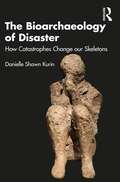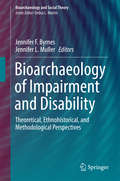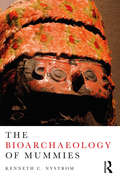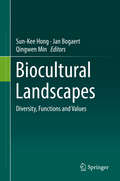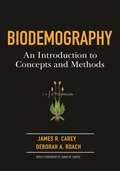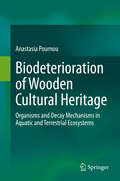- Table View
- List View
The Bioarchaeology of Disaster: How Catastrophes Change our Skeletons
by Danielle Shawn KurinThe Bioarchaeology of Disaster examines two dozen disasters occurring around the world over the past 2,000 years, ranging from natural and environmental disasters to human conflict and warfare, from epidemics to those of social marginalization—all from a bioarchaeological and forensic anthropological perspective. Each case study provides the social, cultural, historical and ecological context of the disaster and then analyzes evidence of human and related remains in order to better understand the identities of victims, the means, processes, and extent of deaths and injuries. The methods used by specialists to interpret evidence and disagreements among experts are also addressed. It will be helpful in understanding the circumstances of a range of disasters and the multidisciplinary ways in which bioarcheologists employ empirical methods and analytic frameworks to interpret their impacts and consequences. The book is intended for those in the social and biological sciences, particularly archaeology, forensics, history and ethnography. It will also be of interest to those in medical history and epidemiology, ecological studies, and those involved in disaster response, law enforcement and human rights work.
The Bioarchaeology of Dissection and Autopsy in the United States (Bioarchaeology and Social Theory)
by Kenneth C. NystromEncountering evidence of postmortem examinations - dissection or autopsy in historic skeletal collections is relatively rare, but recently there has been an increase in the number of reported instances. And much of what has been evaluated has been largely descriptive and historical. The Bioarchaeology of Dissection and Autopsy brings together in a single volume the skeletal evidence of postmortem examination in the United States. Ranging from the early colonial period to the early 1900’s, from a coffeehouse at Colonial Williamsburg to a Quaker burial vault in lower Manhattan, the contributions to this volume demonstrate the interpretive significance of a historically and theoretically contextualized bioarchaeology. The authors employ a wide range of perspectives, demonstrating how bioarchaeological evidence can be used to address a wide range of themes including social identity and marginalization, racialization, the nature of the body and fragmentation, and the emergence of medical practice and authority in the United States.
Bioarchaeology of Impairment and Disability: Theoretical, Ethnohistorical, and Methodological Perspectives (Bioarchaeology and Social Theory)
by Jennifer F. Byrnes Jennifer L. MullerOver the years, impairment has been discussed in bioarchaeology, with some scholars providing carefully contextualized explanations for their causes and consequences. Such investigations typically take a case study approach and focus on the functional aspects of impairments. However, these interpretations are disconnected from disability theory discourse. Other social sciences and the humanities have far surpassed most of anthropology (with the exception of medical anthropology) in their integration of social theories of disability. This volume has three goals: The first goal of this edited volume is to present theoretical and methodological discussions on impairment and disability. The second goal of this volume is to emphasize the necessity of interdisciplinarity in discussions of impairment and disability within bioarchaeology. The third goal of the volume is to present various methodological approaches to quantifying impairment in skeletonized and mummified remains. This volume serves to engage scholars from many disciplines in our exploration of disability in the past, with particular emphasis on the bioarchaeological context.
The Bioarchaeology of Metabolic Bone Disease
by Megan B. Brickley Rachel IvesThe Bioarchaeology of Metabolic Bone Disease provides a comprehensive and invaluable source of information on this important group of diseases. It is an essential guide for those engaged in either basic recording or in-depth research on human remains from archaeological sites. The range of potential tools for investigating metabolic diseases of bone are far greater than for many other conditions, and building on clinical investigations, this book will consider gross, surface features visible using microscopic examination, histological and radiological features of bone, that can be used to help investigate metabolic bone diseases. - Clear photographs and line drawings illustrate gross, histological and radiological features associated with each of the conditions - Covers a range of issues pertinent to the study of metabolic bone disease in archaeological skeletal material, including the problems that frequent co-existence of these conditions in individuals living in the past raises, the preservation of human bone and the impact this has on the ability to suggest a diagnosis of a condition - Includes a range of conditions that can lead to osteopenia and osteoporosis, including previous investigations of these conditions in archaeological bone
The Bioarchaeology of Metabolic Bone Disease
by Megan B. Brickley Rachel Ives Simon MaysThe Bioarchaeology of Metabolic Bone Disease, Second Edition is a comprehensive source dedicated to better understanding this group of conditions that have significant consequences for health in both past and present communities on a global scale. This edition presents an updated introduction to the biology and metabolism of mineralised tissues that are fundamental to understanding the expression of the metabolic bone diseases in skeletal remains. The extensive advances in understanding of these conditions in both bioarchaeological and biomedical work are brought together for the reader. Dedicated chapters focussing on each disease emphasise the integration of up-to-date clinical background with the biological basis of disease progression to give guidance on identification. New chapters covering anaemia and approaches to recognising the co-occurrence of pathological conditions have been included, reflecting recent advances in research. Boxes highlighting significant issues, use of information from sources such as texts and nonhuman primates, and theoretical approaches are included in the text. Each chapter closes with 'Core Concepts' that summarise key information. The final chapter reviews current challenges in bioarchaeology and provides directions for future research. This is a must-have resource for users at all career stages interested in integrating information on the metabolic bone diseases into bioarchaeological projects. - Covers deficiencies of vitamin C and D, osteoporosis (age-related and secondary), Paget's disease of bone, anaemia and approaches to disease co-occurrence - Contains clear and user-friendly guidance for macroscopic, radiological and microscopic diagnoses - Highlights current inquiries and debates in biological anthropology, bioarchaeology, palaeopathology, medical history and clinical/biomedical research - Extensive figures, most new or updated, provide invaluable information on biological processes and lesion expression through diagrams and photographs
The Bioarchaeology of Mummies
by Kenneth C. NystromThe modern manifestation of mummy studies began to take shape in the 1970s and has experienced significant growth during the last several decades, largely due to biomedical interest in soft tissue pathology. Although this points to a vibrant field, there are indications that we need to take stock of where it is today and how it may develop in the future, and this volume responds to those demands. In many ways, mummy studies and skeletal bioarchaeology are "sister-disciplines," sharing data sources, methodologies, and practitioners. Given these close connections, this book considers whether paradigmatic shifts that influenced the development of the latter also impacted the former. Whilst there are many available books discussing mummy research, most recent field-wide reviews adopt a biomedical perspective to explore a particular mummy or collection of mummies. The Bioarchaeology of Mummies is a unique attempt at a synthetic, state-of-the-field critical analysis which considers the field from an explicitly anthropological perspective. This book is written for both skeletal bioarcheologists that may not be familiar with the scope of mummy research, and mummy researchers from biomedical fields that may not be as acquainted with current research trends within bioarchaeology.
The Bioarchaeology of Mummies
by Kenneth C. NystromThe modern manifestation of mummy studies began to take shape in the 1970s and has experienced significant growth during the last several decades, largely due to biomedical interest in soft tissue pathology. Although this points to a vibrant field, there are indications that we need to take stock of where it is today and how it may develop in the future, and this volume responds to those demands. In many ways, mummy studies and skeletal bioarchaeology are "sister-disciplines," sharing data sources, methodologies, and practitioners. Given these close connections, this book considers whether paradigmatic shifts that influenced the development of the latter also impacted the former. Whilst there are many available books discussing mummy research, most recent field-wide reviews adopt a biomedical perspective to explore a particular mummy or collection of mummies. The Bioarchaeology of Mummies is a unique attempt at a synthetic, state-of-the-field critical analysis which considers the field from an explicitly anthropological perspective. This book is written for both skeletal bioarcheologists that may not be familiar with the scope of mummy research, and mummy researchers from biomedical fields that may not be as acquainted with current research trends within bioarchaeology.
The Bioarchaeology of Social Control: Assessing Conflict and Cooperation in Pre-Contact Puebloan Society (Bioarchaeology and Social Theory)
by Ryan P. HarrodTaking a bioarchaeological approach, this book examines the Ancestral Pueblo culture living in the Four Corners region of the United States during the late Pueblo I through the end of the Pueblo III period (AD 850-1300). During this time, a vast system of pueblo villages spread throughout the region creating what has been called the Chaco Phenomenon, named after the large great houses in Chaco Canyon that are thought to have been centers of control. Through a bioarchaeological analysis of the human skeletal remains, this volume provides evidence that key individuals within the hierarchical social structure used a variety of methods of social control, including structural violence, to maintain their power over the interconnected communities.
The Bioarchaeology of Societal Collapse and Regeneration in Ancient Peru (Bioarchaeology and Social Theory)
by Danielle Shawn KurinThis book explores how individuals, social groups, and entire populations are impacted by the tumultuous collapse of ancient states and empires. Through meticulous study of the bones of the dead and the molecules embedded therein, bioarchaeologists can reconstruct how the reverberations of traumatic social disasters permanently impact human bodies over the course of generations. In this case, we focus on the enigmatic civilizations of ancient Peru. Around 1000 years ago, the Wari Empire, the first expansive, imperial state in the highland Andes, abruptly collapsed after four centures of domination. Several hundred years later, the Inca rose to power, creating a new highland empire running along the spine of South America. But what happened in between? According to Andean folklore, two important societies, known today as the Chanka and the Quichua, emerged from the ashes of the ruined Wari state, and coalesced as formidable polities despite the social, political, and economic chaos that characterized the end of imperial control. The period of the Chanka and the Quichua, however, produced no known grand capital, no large, elaborate cities, no written or commercial records, and left relatively little by way of tools, goods, and artwork. Knowledge of the Chanka and Quichua who thrived in the Andahuaylas region of south-central Peru, ca. 1000 – 1400 A.D., is mainly written in bone—found largely in the human remains and associated funerary objects of its population. This book presents novel insights as to the nature of society during this important interstitial era between empires—what specialists call the “Late Intermediate Period” in Andean pre-history. Additionally, it provides a detailed study of Wari state collapse, explores how imperial fragmentation impacted local people in Andahuaylas, and addresses how those people reorganized their society after this traumatic disruption. Particular attention is given to describing how Wari collapse impacted rates and types of violence, altered population demographic profiles, changed dietary habits, prompted new patterns of migration, generated novel ethnic identities, prompted innovative technological advances, and transformed beliefs and practices concerning the dead.
The Bioarchaeology of Socio-Sexual Lives: Queering Common Sense About Sex, Gender, and Sexuality (Bioarchaeology and Social Theory)
by Pamela L. GellerThis volume uses bioarchaeological remains to examine the complexities and diversity of past socio-sexual lives. This book does not begin with the presumption that certain aspects of sex, gender, and sexuality are universal and longstanding. Rather, the case studies within—extend from Neolithic Europe to pre-Columbian Mesoamerica to the nineteenth-century United States—highlight the importance of culturally and historically contextualizing socio-sexual beliefs and practices.The Bioarchaeology of Socio-Sexual Lives highlights a major shortcoming in many scholarly and popular presentations of past socio-sexual lives. They reveal little about the ancient or historic group under study and much about Western society’s modern state of heteronormative affairs. To interrogate commonsensical thinking about socio-sexual identities and interactions, this volume draws from critical feminist and queer studies. Reciprocally, bioarchaeological studies extend social theorizing about sex, gender, and sexuality that emphasizes the modern, conceptual, and discursive. Ultimately, The Bioarchaeology of Socio-Sexual Lives invites readers to think more deeply about humanity’s diversity, the naturalization of culture, and the past’s presentation in mass-media communications.
The Bioarchaeology of Space and Place: Ideology, Power, and Meaning in Maya Mortuary Contexts
by Gabriel D. WrobelThe Bioarchaeology of Space and Place investigates variations in social identity among the ancient Maya by focusing on individuals and small groups identified archaeologically by their inclusion in specific, discrete mortuary contexts or by unusual mortuary treatments. Utilizing archaeological, biological and taphonomic data from these contexts, the studies employ a variety of methodological approaches to reconstruct aspects of individuals’ life-course and mortuary pathways. Following this, specific mortuary behaviors are discussed in relation to their local or regional cultural setting using relevant archaeological, ethnohistoric, and/or ethnographic data in an effort to interpret their meaning within the broader social, political and economic contexts in which they were carried out. This volume covers a number of topics that are currently being debated in Maya archaeology, including identification and discussion of the role and extent of human sacrifice in Maya culture, the use of ancestors for maintaining political power, the mortuary use of caves by both elites and non-elites, ethnic distinctions within urban areas and the extent of movement of people between communities. Importantly, the papers in this volume attempt to test and move beyond static, dichotic categories that are often employed in mortuary studies in an effort to better understand the complex ways in which the Maya conceptualized and manipulated social identity. This type of nuanced case-study approach that incorporates historical, archaeological and theoretical contextualization is becoming increasingly important in the field of bioarchaeology, providing valuable sources of data where small, diverse samples impede populational approaches.
The Bioarchaeology of Structural Violence: A Theoretical Framework for Industrial Era Inequality (Bioarchaeology and Social Theory)
by Lori A. Tremblay Sarah ReedyThis volume is a resource for bioarchaeologists interested in using a structural violence framework to better understand and contextualize the lived experiences of past populations. One of the most important elements of bioarchaeological research is the study of health disparities in past populations. This book offers an analysis of such work, but with the benefit of an overarching theoretical framework. It examines the theoretical framework used by scholars in cultural and medical anthropology to explore how social, political, and/or socioeconomic structures and institutions create inequalities resulting in health disparities for the most vulnerable or marginalized segments of contemporary populations. It then takes this framework and shows how it can allow researchers in bioarchaeology to interpret such socio-cultural factors through analyzing human skeletal remains of past populations. The book discusses the framework and its applications based on two main themes: the structural violence of gender inequality and the structural violence of social and socioeconomic inequalities.
The Bioarchaeology of Urbanization: The Biological, Demographic, and Social Consequences of Living in Cities (Bioarchaeology and Social Theory)
by Tracy K. Betsinger Sharon N. DeWitteUrbanization has long been a focus of bioarchaeological research, but what is missing from the literature is an exploration of the geographic and temporal range of human biological, demographic, and sociocultural responses to this major shift in settlement pattern. Urbanization is characterized by increased population size and density, and is frequently assumed to produce negative biological effects. However, the relationship between urbanization and human “health” requires careful examination given the heterogeneity that exists within and between urban contexts. Studies of contemporary urbanization have found both positive and negative outcomes, which likely have parallels in past human societies.This volume is unique as there is no current bioarchaeological book addressing urbanization, despite various studies of urbanization having been conducted. Collectively, this volume provides a more holistic understanding of the relationships between urbanization and various aspects of human population health. The insight gained from this volume will provide not only a better understanding of urbanization in our past, but it will also have potential implications for those studying urbanization in contemporary communities.
Bioarchaeology of Women and Children in Times of War: Case Studies from the Americas (Bioarchaeology and Social Theory)
by Debra L. Martin Caryn TegtmeyerThis volume will examine the varied roles that women and children play in period of warfare, which in most cases deviate from their perceived role as noncombatants. Using social theory about the nature of sex, gender and age in thinking about vulnerabilities to different groups during warfare, this collection of studies focuses on the broader impacts of war both during warfare but also long after the conflict is over.The volume will show that during periods of violence and warfare, many suffer beyond those individuals directly involved in battle. From pre-Hispanic Peru to Ming dynasty Mongolia to the Civil War-era United States to the present, warfare has been and is a public health disaster, particularly for women and children. Individuals and populations suffer from displacement, sometimes permanently, due to loss of food and resources and an increased risk of contracting communicable diseases, which results from the poor conditions and tight spaces present in most refugee camps, ancient and modern.Bioarchaeology can provide a more nuanced lens through which to examine the effects of warfare on life, morbidity, and mortality, bringing individuals not traditionally considered by studies of warfare and prolonged violence into focus. Inclusion of these groups in discussions of warfare can increase our understanding of not only the biological but also the social meaning and costs of warfare.
Bioart Kitchen: Art, Feminism and Technoscience (International Library of Modern and Contemporary Art)
by Lindsay KelleyWhat do new technologies taste like? A growing number of contemporary artists are working with food, live materials and scientific processes, in order to explore and challenge the ways in which manipulation of biological materials informs our cooking and eating.
Biobanks: Governance in Comparative Perspective
by Herbert Gottweis Alan PetersenIn recent years, a number of large population-based biobanks – genetic databases that combine genetic information derived from blood samples with personal data about environment, medical history, lifestyle or genealogy – have been set up in order to study the interface between disease, and genetic and environmental factors. Unsurprisingly, these studies have sparked a good deal of controversy and the ethical and social implications have been widely debated. Biobanks: Governance in Comparative Perspective is the first book to explore the political and governance implications of biobanks in Europe, the United States, Asia, and Australia. This book explores: the interrelated conditions needed for a biobank to be created and to exist the rise of the new bio-economy the redefinition of citizenship accompanying national biobank developments This groundbreaking book makes clear that biobanks are a phenomenon that cannot be disconnected from considerations of power, politics, and the reshaping of current practices in governance. It will be a valuable read for scholars and students of genetics, bioethics, risk, public health and the sociology of health and illness.
Biobanks: Governance in Comparative Perspective
by Herbert Gottweis Alan PetersenIn recent years, a number of large population-based biobanks – genetic databases that combine genetic information derived from blood samples with personal data about environment, medical history, lifestyle or genealogy – have been set up in order to study the interface between disease, and genetic and environmental factors. Unsurprisingly, these studies have sparked a good deal of controversy and the ethical and social implications have been widely debated. Biobanks: Governance in Comparative Perspective is the first book to explore the political and governance implications of biobanks in Europe, the United States, Asia, and Australia. This book explores: the interrelated conditions needed for a biobank to be created and to exist the rise of the new bio-economy the redefinition of citizenship accompanying national biobank developments This groundbreaking book makes clear that biobanks are a phenomenon that cannot be disconnected from considerations of power, politics, and the reshaping of current practices in governance. It will be a valuable read for scholars and students of genetics, bioethics, risk, public health and the sociology of health and illness.
Biobazaar: The Open Source Revolution and Biotechnology
by Janet HopeFighting disease, combating hunger, preserving the balance of life on Earth: the future of biotechnological innovation may well be the future of our planet itself. And yet the vexed state of intellectual property law—a proliferation of ever more complex rights governing research and development—is complicating this future. At a similar point in the development of information technology, “open source” software revolutionized the field, simultaneously encouraging innovation and transforming markets. The question that Janet Hope explores in Biobazaar is: can the open source approach do for biotechnology what it has done for information technology? Her book is the first sustained and systematic inquiry into the application of open source principles to the life sciences. The appeal of the open source approach—famously likened to a “bazaar,” in contrast to the more traditional “cathedral” style of technology development—lies in its safeguarding of community access to proprietary tools without discouraging valuable commercial participation. Traversing disciplinary boundaries, Hope presents a careful analysis of intellectual property-related challenges confronting the biotechnology industry and then paints a detailed picture of “open source biotechnology” as a possible solution. With insights drawn from interviews with Nobel Prize–winning scientists and leaders of the free and open source software movement—as well as company executives, international policymakers, licensing experts, and industry analysts—her book suggests that open source biotechnology is both desirable and broadly feasible—and, in many ways, merely awaiting its moment.
Biocracy: Public Policy And The Life Sciences
by Lynton Keith CaldwellBiocracy, a term invented by physiologist Walter Bradford Cannon, refers to the influence of biological science on society and its public policies. Beginning with the prophetic essay “Biopolitics: Science, Ethics, and Public Policy,†this book addresses various aspects of the relationships among the life sciences, society, and government. Included in the topics considered are some of the more critical issues of our time: the social responses to life science innovations; health and homeostasis as social concepts; the relationship between history and biology and that between the life sciences and the law; biocratic interpretations of ethical behavior and biopolitical conflicts; and the options, risks, and international consequences of biotechnology. Caldwell’s book is a collection of articles that he wrote on this subject over a period of twenty-five years. Of the ten chapters, four have previously appeared in scholarly journals but have undergone extensive editorial revisions appropriate to this publication. The remaining six chapters have been presented at various professional meetings but have not hitherto been available in print.
Biocracy: Public Policy And The Life Sciences
by Lynton Keith CaldwellBiocracy, a term invented by physiologist Walter Bradford Cannon, refers to the influence of biological science on society and its public policies. Beginning with the prophetic essay “Biopolitics: Science, Ethics, and Public Policy,†this book addresses various aspects of the relationships among the life sciences, society, and government. Included in the topics considered are some of the more critical issues of our time: the social responses to life science innovations; health and homeostasis as social concepts; the relationship between history and biology and that between the life sciences and the law; biocratic interpretations of ethical behavior and biopolitical conflicts; and the options, risks, and international consequences of biotechnology. Caldwell’s book is a collection of articles that he wrote on this subject over a period of twenty-five years. Of the ten chapters, four have previously appeared in scholarly journals but have undergone extensive editorial revisions appropriate to this publication. The remaining six chapters have been presented at various professional meetings but have not hitherto been available in print.
Biocultural Landscapes: Diversity, Functions and Values
by Sun-Kee Hong Jan Bogaert Qingwen MinThis book is devoted to the cultural and biological dimensions and values of landscapes, linking the concepts of biodiversity, landscape and culture and presenting an essential approach for landscape analysis, interpretation and sustainable dynamics.Early chapters explore the concepts and values of biocultural landscapes, before addressing the methodology to identify the relationship between biological and cultural diversity. The volume continuous with a series of case studies and with an exploration of the key role of biocultural diversity in contemporary landscape ecology.Readers will learn the importance of landscapes for different fields of natural and human sciences and are confronted to the trans-disciplinary nature of the landscape concept itself. A hierarchical approach to landscapes, in which they are composed of interacting (eco)systems, is shown to be essential in recognizing their emergent properties.In this work, the biocultural values of landscapes are explored through their diversity in geographical scopes, methodological approaches and conceptual assumptions. Authors from Asia, Europe and North-America present diverse research experiences and views on biocultural landscapes, their pattern, conservation and management.Landscape ecologists will find this work particularly appealing, as well as anyone with an interest in sustainable landscape development, nature conservation or cultural heritage management.This volume is the outcome of a symposium on “Biodiversity in Cultural Landscapes”, organized in the framework of the 8th IALE World Congress, held in Beijing in 2011.
Biodemography: An Introduction to Concepts and Methods
by James R. Carey Deborah RoachAn authoritative overview of the concepts and applications of biological demographyThis book provides a comprehensive introduction to biodemography, an exciting interdisciplinary field that unites the natural science of biology with the social science of human demography. Biodemography is an essential resource for demographers, epidemiologists, gerontologists, and health professionals as well as ecologists, population biologists, entomologists, and conservation biologists. This accessible and innovative book is also ideal for the classroom.James Carey and Deborah Roach cover everything from baseline demographic concepts to biodemographic applications, and present models and equations in discrete rather than continuous form to enhance mathematical accessibility. They use a wealth of real-world examples that draw from data sets on both human and nonhuman species and offer an interdisciplinary approach to demography like no other, with topics ranging from kinship theory and family demography to reliability engineering, tort law, and demographic disasters such as the Titanic and the destruction of Napoleon's Grande Armée.Provides the first synthesis of demography and biologyCovers baseline demographic models and concepts such as Lexis diagrams, mortality, fecundity, and population theoryFeatures in-depth discussions of biodemographic applications like harvesting theory and mark-recaptureDraws from data sets on species ranging from fruit flies and plants to elephants and humansUses a uniquely interdisciplinary approach to demography, bringing together a diverse range of concepts, models, and applicationsIncludes informative "biodemographic shorts," appendixes on data visualization and management, and more than 150 illustrations of models and equations
Biodemography of Aging: Determinants of Healthy Life Span and Longevity (The Springer Series on Demographic Methods and Population Analysis #40)
by Anatoliy I. Yashin Eric Stallard Kenneth C. LandThis volume is a critical exposition of the data and analyses from a full decade of rigorous research into how age-related changes at the individual level, along with other factors, contribute to morbidity, disability and mortality risks at the broader population level. After summarizing the state of our knowledge in the field, individual chapters offer enlightening discussion on a range of key topics such as age trajectory analysis in select and general populations, incidence/age patterns of major chronic illnesses, and indices of cumulative deficits and their use in characterizing and understanding the detailed properties of individual aging.The book features comprehensive statistical analyses of unique longitudinal data sets including the unique resource of the Framingham Heart Study, with its more than 60 years of follow-up. Culminating in penetrating conclusions about the insights gained from the work involved, this book adds much to our understanding of the links between aging and human health.
Biodemography of Fertility in Japan (SpringerBriefs in Population Studies)
by Shoko Konishi Emi Tamaki Jun YoshinagaThis book presents original data on the proximate determinants of fertility in Japan. Its goal is to disaggregate low fertility levels in Japan into physiological, behavioral, and social components. Further, the book reviews previous studies on the proximate determinants of fertility in Japan, and compares the data to that on other countries. This book is the first to summarize previous research projects conducted in Japan on this topic, and proposes future research directions to fill the remaining research gaps. Further, it sheds new light on the similarities and differences between the fertility level in Japan and in other countries in terms of biodemographical components, helping readers understand the mechanisms of fertility change in Japan.
Biodeterioration of Wooden Cultural Heritage: Organisms and Decay Mechanisms in Aquatic and Terrestrial Ecosystems
by Anastasia PournouSince prehistoric times and throughout the course of human evolution, wood has been an integral part of all civilizations. Wooden Cultural Heritage can be found worldwide, providing valuable information on the social and economic context of human history. Nonetheless, as a natural cellulosic material, wood shows low resistance to biodeterioration and thus wooden Cultural Heritage often fails to escape decomposition in both aquatic and terrestrial ecosystems. This book provides a comprehensive overview on the biodeterioration of wooden Cultural Heritage and describes the decay mechanisms of key organisms and microorganisms encountered in aquatic and terrestrial ecosystems. Cultural Heritage professionals, researchers and academics may explore within this book the associations between deteriogens, habitats and decay, which will assist them to understand wood biodeterioration and design effective prevention, mitigation and remediation strategies. The book presents case studies around the world to demonstrate the impact of biogenic deterioration on wooden Cultural Heritage and illustrates mechanisms and patterns in order to be a useful handbook of decay diagnosis.Lastly, by adopting a holistic approach to wood decay, basic concepts of wood technology, ecology, and deteriogens' biology are introduced, permitting readers of different scientific backgrounds to easily comprehend wood biodeterioration.
